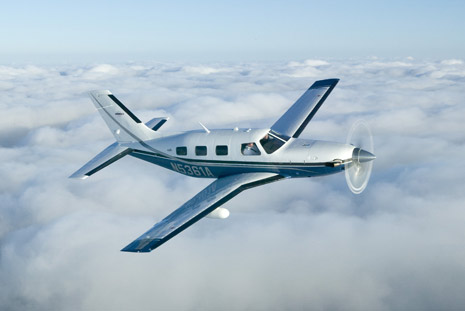 Piper’s Meridian is an outgrowth of the Malibu/Mirage design that utilizes a 500-shaft-horsepower Pratt & Whitney PT6-42A in place of a 350-horsepower Lycoming or 310-horsepower Continental piston engine. Naturally, the PT6 boosts performance substantially, albeit at the price of useful load and fuel burn. Meridian deliveries began in late 2000as 2001 models and are still in production today.
Piper’s Meridian is an outgrowth of the Malibu/Mirage design that utilizes a 500-shaft-horsepower Pratt & Whitney PT6-42A in place of a 350-horsepower Lycoming or 310-horsepower Continental piston engine. Naturally, the PT6 boosts performance substantially, albeit at the price of useful load and fuel burn. Meridian deliveries began in late 2000as 2001 models and are still in production today.
A Meridian is more than just a Mirage with a turbine in the nose. Meridians have a larger horizontal stabilizer to counteract the added power and a larger wing root to hold the extra fuel required for the thirstier engine. Maximum takeoff weight is also about 500 pounds more than the Mirage, at 4,850 pounds.
When it first appeared, the Meridian’s skimpy maximum takeoff weight proved to be a real impediment to the airplane’s usefulnessin hauling people and gear. Early airplanes could only carry about 350 pounds of payload with full fuel. Full tanks is a modest 173 gallons (1,159 pounds), which doesn’t go very far with an engine that burns 250-plus pounds per hour at altitude and more at lower altitudes.
Starting with the 2003 model, Piper boosted the gross weight of the Meridian to 5,092 pounds while maintaining the FAA-required 61-knot stall speed. This was accomplished by adding vortex generators to the top of the wing and on the underside of the horizontal stabilizer. The additional 242 pounds was welcome—and retrofittable to older models.
Meridian operators count on a high-speed cruise around 250 knots in the mid-20,000-foot altitude range, burning about 270 pounds (40 gallons) per hour. Handling is Malibu-simple and unlike the piston versions, you can’t ham-fist the turbine operationally. Reliability and TBO (3,600 hours) of the turbine also are substantially higher than those of the piston iterations, bringing safety and confidence to the Meridian owner. This, of course, is accompanied by the substantial $200,000 cost to overhaul the PT6, according to Vref Online.
Early Meridians are equipped with Meggitt MAGIC avionics and a Meggitt (S-Tec) 550 autopilot. In 2003, Meggitt introduced its own MAGIC 1500 digital autopilot to complement the system. In 2006, Avidyne’s Entegra became the avionics of choice—followed in 2010 by the Garmin G1000, which is standard equipment on new models. Older Meridians can be updated to Garmin’s 950 suite with Cutter Aviation’s retrofit (see “The G950 Meridian,” May 2013 AOPA Pilot).
Used Meridian prices range from $775,000 for a 2001 model to nearly $2 million for a 2013 model, according to Vref. On the whole, the Meridian is an economical, reliable, and safe turboprop for a family or small corporation on short to medium-length trips.
Pete Bedell is a pilot for a major airline andco-owner of a Cessna 172 and Beechcraft Baron D55.
SPEC SHEET
Piper Meridian
Powerplant | 500-shp Pratt & Whitney PT6-42A
Length | 29 ft 7 in
Height | 11 ft 4 in
Wingspan | 43 ft
Seats | 6
Max takeoff weight | 5,092 lb
Takeoff distance over 50-ft obstacle | 2,500 ft
Max cruise speed, 25,000 ft | 262 kt
Landing distance over 50-ft obstacle | 2,200 ft
Range | 960 nm


